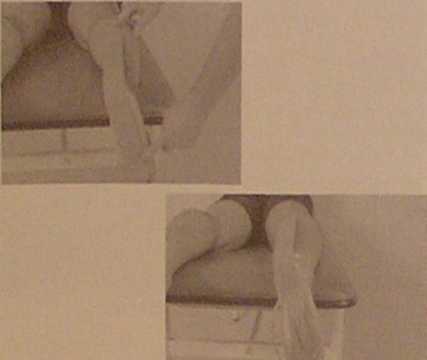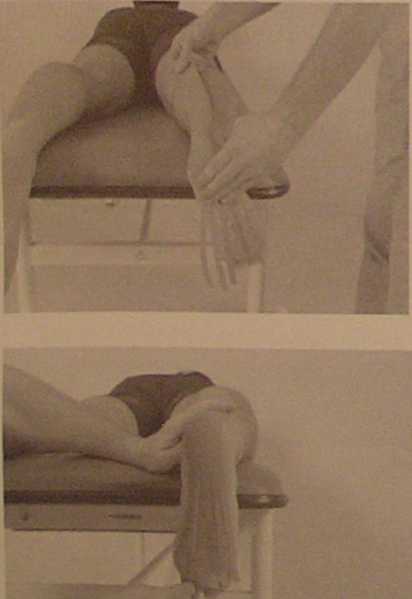P5140120
Plantar Fasciitis
Plantar Fasciitis is an inflammation of the plantar aponeurosis. Pain and inflammation are generally fclt at its' origin on the epicondyle of the calcaneous (antcrior aspcct of calcaneous).
Two strips are applicd to the plantar surface of the foot. Strip one using a fan cut, wili be placed along the length of the plantar aponeurosis with fuli iension remoyed. On the plantar surface fuli tcnsion can be removed with little or no irritation to the skin, due to skin thickness. Strip two, using a mechanical correction technique, will be placed across the mid-arch to assist with metatarsal arch support. It is highly recommended that both strips be used The effectiveness of the technique is compromised with the use of only one strip.
This tcchnique can be applied multiple times. Use of water resistant Kinesio Tex is recommended. During acute inflammation the technique should indude the Achilles tendon and plantar aponeurosis for maximum cffect.


Measure the entire length of from the metatarsal heads to approximately 2 inches above the musculo-tendinous junction of the gastrocnemius and Achilles. On one end cut a 4 strip fan technique from the metatarsal heads to the calcaneal tuberde. When first utilizing this technique remember that all of the tension will be removed from the Kinesio Tex, so cut your strip a little shorter than measured.

The Kinesio strip paper backing is tom just superior to the fan. The Kinesio strip is begun on the heel with the foot in dorsi flexion.
While holding the tape which has been applied to the heel, to ensure no tension will be added to the tape, apply tension over the Achilles tendon. Apply a tendon correction technique using moderate, 25-50 % of available tension over the Achilles'. For review see correction technique.
When the Kinesio strip has reached the musculo-tendinous junction, lay down the end of the Kinesio strip with very light to light, 10-25% of available tension, until the last two inches which is laid down with no tension. Initiate glue prior to any further movement.
Keeping the foot in dorsi flexion begin by applying fuli, 100% of available tension on one of the four strips which have been cut. Place this strip from the calcaneous to the space between the first and second ray (toe) on the metatarsal head. Make surę you activate the glue before additional strips are placed.
Continuc the same process by placing a strip of Kinesio Tex between the second and third, third and fourth and fourth and fifth toes.
The second Kinesio Strip is a metatarsal arch mechanical correction. For review sec metatarsal arch technique.
Have the patient move into foot dorsiflexion apply the base of the Kinesio I strip with no tension near the 5th metatarsal base on the lateral aspect of the foot. The edge of the Kinesio strip begins on the base of the 5th and finishes up the shaft of the bonę.
Prior to tape application you may want to initially estimate the path of the Kinesio strip to assist in pro per placement. The Kinesio strip is angled for the tarsal metatarsal joint on the medial aspect of the foot.
Have the patient relax their foot. Apply light to moderate, 25-50% of available tension from the base of the 5th metatarsal to the tarsal navicular joint region. The Kinesio strip is applied using the mechanical correction techniąue, tension and down-ward pressure. The amount of tension and down-ward pressure is determined by the practitioner and the size of the patient.
When applied correctly, the patients foot should show signs of "crinkles" in the metatarsal arch region.
Completed Plantar Fasciitis Kinesio Techniąue.
195
Wyszukiwarka
Podobne podstrony:
P5140121 Plantar Fasciitis Plantnr Fnsditis is on inflammation of the plantar aponeurosis. Pain and
2013 Editor: KAŹMIERCZAK).CONCLUSIONS Laparoscopy is an opportunity for patients to less pain and fa
136 15g jpeg Space Environment Center The Space Enwonment Center (SEC) is an agency of the Departmen
11 4 Efficient negotiators, charismatic managers do not raise their voice during the discussion - it
5 (1921) BIG 4 The Big 4 is world renowncd for reliability. It is buiit throughout of the finest mat
P5140103 Pes Anserinus Bursitis or Tendonitis Pes anserinus bursitis or tendonitis is an inflammatio
P5140109 Sever s Syndrome or Apophysitis of the Calcaneus Scver s syndrome is an inflammation of the
P5140106 Achilles Tendonitis or Tenosynovitis Achilles tendonitis is an inflammation to the Achilles
P5140084 Sciatica is an inflammation to the sciatic nerve which is generally associated with Iow bac
P5140025 Cervical Spondylitis Cenical spondylitis is an inflammation of one or morę vertebrae in the
skanowanie0007 2 HOW TO DESCRIBE ANGLES ABC is a thirty degree angle. B C ABC is an angle of thirty
jff 119 GLOSSARY The use of Japanese terms has been kept to a minimum in this book. It is an imposit
więcej podobnych podstron